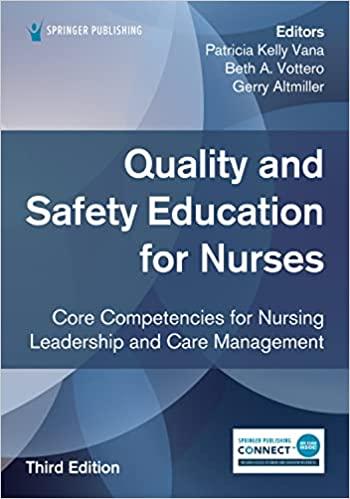A nurse, working part-time in a three-unit long-term care (LTC) facility with two other RNs on New
Question:
A nurse, working part-time in a three-unit long-term care (LTC) facility with two other RNs on New Year’s Day, begins the morning with assessments of all assigned patients. The nurse first assesses Mr. Malcom Green, who is with his wife, Mrs. Rosa Green, celebrating the last day of Kwanzaa. Mr. Green is a 75-year-old obese male admitted after a series of falls at home. He is cognitively intact and able to perform a majority of his own activities of daily living (ADL). Mrs. Green is concerned about Mr. Green’s problems, which she states “have been obvious some times and not so obvious at other times, since he came here” and “have been getting worse over the last two weeks.”
After a review of Mr. Green’s electronic health record (EHR), it is noted that he was transported to his PCP’s office 2 days ago for blood pressure (BP) above 140/90 and he was transported to the local emergency department (ED) 6 days ago with complaints of chest pain. Other past symptoms listed in the LTC facility transport notes include complaints of dizziness, a bloody nose, intermittent headache, heart palpitations, tiredness, chest pain, and blurred vision. The PCP’s notes, from prior visits, are in the EHR but the ED report cannot be located. According to Mr. Green, his current symptoms include dizziness, headache, tiredness, and blurred vision. Looking back over the past 2 months, you find the following BP readings in the LTC facility EHR (oldest to newest BP readings): 130/90, 120/80, 140/80, 120/80, 130/90, 120/52, and 148/96. The reading of 148/96 resulted in Mr. Green’s most recent visit to his PCP. Readings recorded in the PCP’s office were 156/102, 140/80, and 128/74. Today’s BP reading is 112/60. There is no documented change in medication, or other orders, after Mr. Green’s PCP’s office appointment or after his visit to the local ED. His medications have not changed in 7 months.
The unit’s care team today includes three medical assistants who usually work on other units. Mr. Green’s care is discussed with the unit’s care team, but nothing new related to his activities of daily living, dietary intake, mobility, or symptoms is mentioned. Mr. Green’s complaints and BP readings are discussed at the facility’s RN huddle with the two other RNs at the facility. The full-time department heads are not working.
Orders for Mr. Green indicate that his BP be taken weekly. Protocols for the LTC facility indicate
(a) a call to the PCP when the patient’s BP reading is above 140/90 after three consecutive readings separated by 1 or 2 minutes and
(b) transport to the local ED, if the BP is above 180/110. Facility protocols are based on available evidence and include the Guideline for the Prevention, Detection, Evaluation, and Management of High Blood Pressure in Adults (Whelton et al., 2018).
1.
What CUES (Assessment) can the nurse assess
(a) for Mr. Green?
(b) for a population similar to Mr. Green?
2.
What HYPOTHESIS (Diagnosis will the nurse consider
(a) for Mr. Green?
(b) for a similar population?
3.
What ACTION (Plan and Implement) will be most effective for the nurse to take to assure
(a) Mr. Green’s safety in this situation?
(b) the safety of a similar population?
4.
For
(a) Mr. Green and
(b) a similar population, how will the nurse evaluate the OUTCOME (Evaluation) for the purpose of arriving at a satisfactory clinical outcome?
Step by Step Answer:

Quality And Safety Education For Nurses Core Competencies For Nursing Leadership And Care Management
ISBN: 9780826161444
3rd Edition
Authors: Patricia Kelly Vana, Beth A. Vottero, Gerry Altmiller






